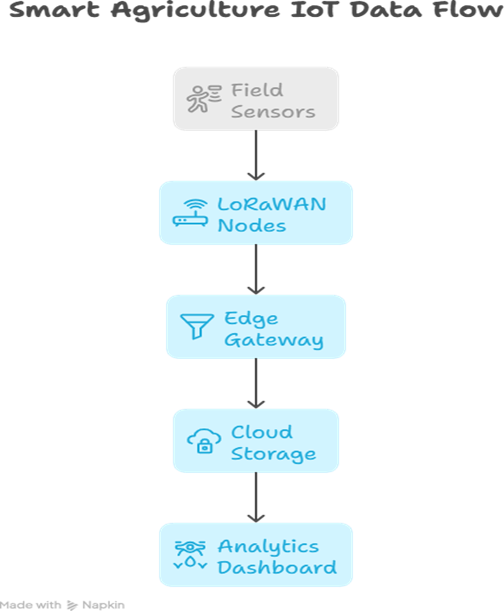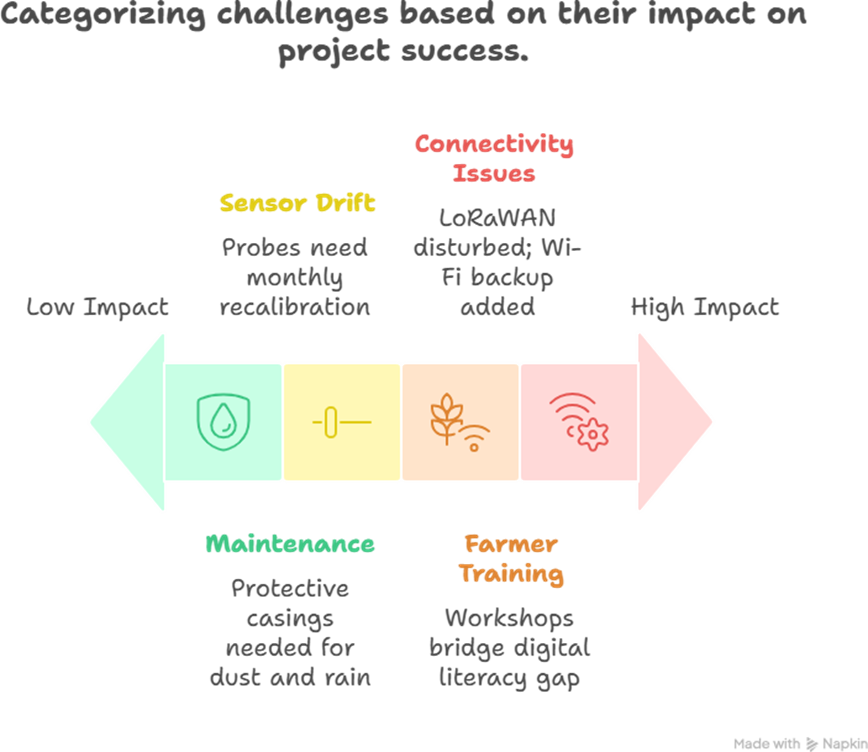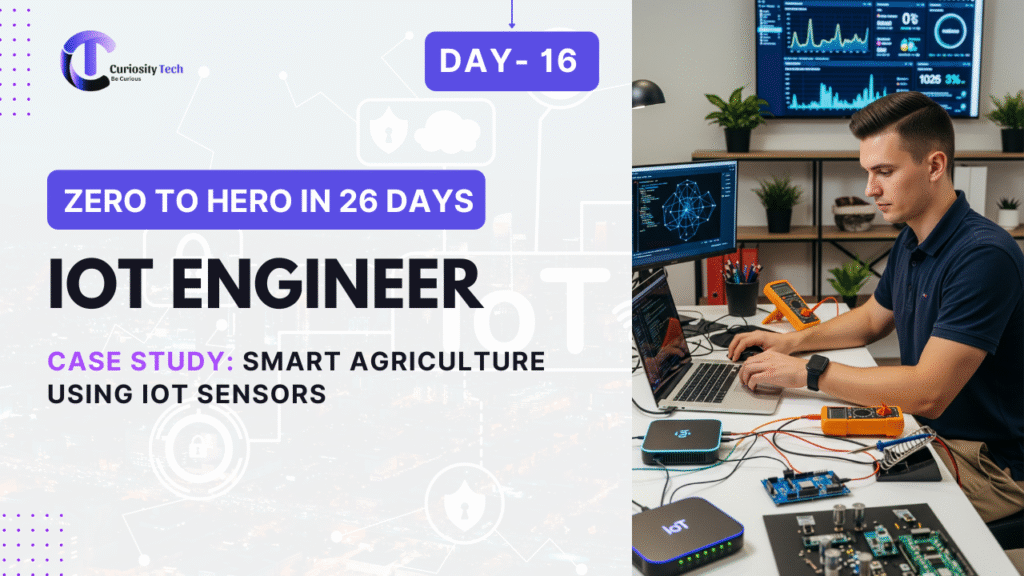Introduction – The Field Story
On the outskirts of Nagpur, a small village farm stands as a living example of how IoT sensors are reshaping agriculture in India. This isn’t a futuristic story — it is happening in 2025. Farmers are no longer relying solely on intuition or experience; instead, they are guided by thousands of bytes of real-time data streaming from sensors buried in soil and mounted on poles.
The following is a field-report case study of a real smart agriculture project carried out in partnership with CuriosityTech.in Nagpur labs. It documents sensor choices, setup methodology, challenges, outcomes, and direct farmer experiences.
Project Background
- Objective: Increase crop yield and water efficiency using IoT-based soil, temperature, and humidity monitoring.
- Location: Farmlands near Wardha Road, Gajanan Nagar (Nagpur).
- Scale: 30 acres of wheat & tomato cultivation.
- Team: Farmers’ cooperative + IoT interns trained at CuriosityTech Lab.
The IoT Setup
Sensors Deployed
- Soil Moisture Sensors (Capacitive Type): Inserted at root-depth across multiple plots.
- Temperature & Humidity Sensors (DHT22): Installed in greenhouse and open fields.
- Rainfall Gauge Sensors: Detected rainfall events for irrigation planning.
- Light (LDR + Lux sensors): Measured sunlight exposure.
- pH Sensor: Monitored soil acidity/alkalinity affecting tomato crops.
Gateways and Controllers
- Microcontrollers: ESP32 boards (low-cost, Wi-Fi enabled).
- Connectivity: LoRaWAN base station set up to cover wide farmland range.
- Edge Gateway: Raspberry Pi running Node-RED to filter data.
Cloud and Dashboard
- Platform: Google Cloud IoT Core integrated with BigQuery.
- Visualization: ThingsBoard dashboard linked to farmer’s smartphones.
Workflow Pipeline (Described)

Diagram (descriptive): A block diagram showing “soil → sensor → LoRa node → gateway → cloud → dashboard → farmer smartphone.”
Data Stories – Real-Time Insights
Example Dataset (Soil Moisture on Wheat Plot)
| Date | Soil Moisture (%) | Irrigation Triggered | Crop Status |
| Mar 5 | 15% (critical low) | Yes (pump ON) | Recovered |
| Mar 6 | 30% (optimal) | No | Stable |
| Mar 10 | 18% (below threshold) | Yes | Growth maintained |
This dataset story: Previously farmers irrigated on fixed schedules, wasting water. Now, irrigation is triggered only when soil moisture < 20%. Water use reduced by 33%.
Farmer’s Voice (Interview Excerpt)
Mr. Pramod, a farmer from Gajanan Nagar:
“Earlier, we watered every alternate day regardless of the soil’s needs. Sometimes the crop withered because we watered late, sometimes we wasted electricity and water unnecessarily. With IoT sensors, a mobile alert tells us exactly when to irrigate. My yield increased, but the bigger benefit is saving electricity during night shifts.”
Engineer’s Note (CuriosityTech Mentor)
Mr. Sharma, IoT trainer at CuriosityTech lab:
“The sensors alone are not enough — calibration was critical. Soil sensors drift due to clay content, so we spent weeks adjusting readings with baseline gravimetric tests. But once tuned, accuracy improved dramatically, and dashboard values aligned with crop behavior.”
ROI & Impact Analysis
Agricultural ROI Table
| Parameter | Before IoT | After IoT Implementation | Improvement |
| Average Yield (wheat) | 2.1 tons/acre | 2.5 tons/acre | +19% |
| Water Use per Acre | ~6500 liters/month | ~4300 liters/month | -33% |
| Fertilizer Use | Manual scheduling | Linked with soil pH alerts | -15% |
| Crop Losses | Frequently from under/over-watering | Significantly reduced | Major savings |
| ROI Period | — | Initial investment paid back in < 1 season | — |
Challenges Faced in Deployment

Key Lessons Learned
- Low-cost sensors must be calibrated for field accuracy.
- Connectivity mix (LoRaWAN + fallback Wi-Fi) ensures reliability.
- Data dashboards must be bilingual (English + local language) for farmer usability.
- Community adoption improves results — when multiple farmers use the same IoT gateway, costs reduce.
Future Scope for Smart Agriculture IoT
- AI-based Pest Prediction: Linking leaf wetness and humidity data with ML models.
- Automated Fertigation: IoT valves inject fertilizer based on soil sensor readings.
- Satellite Data Fusion: Merging IoT ground sensors with satellite NDVI imagery.
- Blockchain Traceability: Crop lifecycle data stored securely across shared ledgers for export compliance.
CuriosityTech’s Continuing Role
At CuriosityTech.in Nagpur, such projects are repeated every year with new experimentation on crop varieties. Students and farmers co-create solutions:
- Engineering students learn deployment challenges directly from the field.
- Farmers gain trust through hands-on technology that increases yield.
- Startups incubate products like “Smart Irrigation Kits” based on these learnings to sell in rural markets.
This fusion of labs + farms represents the future of skill development in IoT.
Conclusion
This case study on smart agriculture demonstrates how IoT sensors can transform traditional farming into data-driven, efficient, and sustainable cultivation. With calibrated soil sensors, precise irrigation triggers, cloud dashboards, and community training, IoT delivers both economic ROI and environmental sustainability.
For the IoT engineer in 2025, agriculture is one of the most fertile (pun intended) lands of opportunity. It shows that technology isn’t just for cities or factories — it can empower rural livelihoods directly. And with platforms like CuriosityTech.in Nagpur, this transformation is accelerating across India, one farm at a time.


